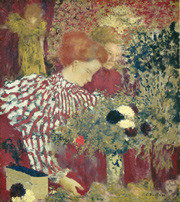Edouard Vuillard
dal 3/5/2012 al 22/9/2012
Segnalato da
3/5/2012
Edouard Vuillard
The Jewish Museum, New York
A Painter and His Muses, 1890-1940. The presentation focuses on the inspiration provided by friends and patrons whose support became inseparable from the artist's achievement. Featuring some fifty key artworks in various media, the exhibition extends pioneering past projects of The Jewish Museum, New York, on the significance of collectors and patrons for the development of modern art.

This exhibition offers a fresh view of the French artist Edouard Vuillard’s career, from the vanguard 1890s to the urbane domesticity of the lesser-known late portraits. The presentation focuses on the inspiration provided by friends and patrons whose support became inseparable from the artist's achievement. Featuring some fifty key artworks in various media, the exhibition extends pioneering past projects of The Jewish Museum, New York, on the significance of collectors and patrons for the development of modern art.
Edouard Vuillard: A Painter and His Muses, 1890-1940 considers six aspects of the artist's creation:
Vuillard's Artistic Beginnings: Son, Artist, Prophet
As a young man in the 1890s, Vuillard was a member of a Parisian group of avant-garde artists known as the Nabis ("prophets" in Hebrew and Arabic). Taking their inspiration from the Post-Impressionist Paul Gauguin, the group used simplified form and pure colors to create decorative, emotionally charged pictures. During his Nabi period, Vuillard produced some of his best-known artworks: paintings of friends and family in warm interiors filled with patterned wallpapers, draperies, carpets, and clothing. Vuillard's close involvement with modern experimental theater brought him into contact with major figures of Parisian cultural life and sparked his interest in painting mural-size scenes.
The Muse and the Review
Vuillard was drawn to the important cultural review published by the Natanson family, La Revue Blanche. The artist's connection with Thadée Natanson vaulted Vuillard to success during the 1890s. From a family of bankers, Thadée and his gifted wife, Misia, were the prime movers who brought together the cream of Parisian intellectuals—avant-garde artists, writers, theatrical impresarios, politicians, and philosophers of the period. Vuillardʹs graphics appeared in the journal, together with those of his fellow artists—Pierre Bonnard, Henri de Toulouse-Lautrec, Félix Vallotton, and others.
New Patrons
In the early years of the twentieth century, Vuillard began to exhibit at the prestigious Bernheim-Jeune gallery. Bernheim-Jeune was a center of the modern movement in painting and represented such leading artists as Bonnard, Matisse, and Renoir. Vuillard's art continued to focus on interiors with figures, in which his artistic friends and circle of patrons are set within their domestic environment. He famously remarked, "I don’t do portraits. I paint people in their surroundings.”
The portentous friendship with Jos Hessel, senior partner of Bernheim-Jeune, and his wife, Lucy, became of central importance for Vuillardʹs creative life. Supporter, confidante, and lover, Lucy Hessel became the artist's most frequent model—appearing in many of the artistʹs paintings, works on paper, and photographs over a period of forty years.
Decorative Murals
In addition to becoming the bespoke portraitist of interwar Paris, Vuillard continued to explore large-scale scenes and groups of scenes—landscapes and cityscapes as well as interiors. His art developed in response to commissions from influential clients. In the big decorative projects, the artist elaborated on the themes of Paris and country life: examples in the exhibition include The Album (1895, commissioned by Thadée Natanson), Place Vintimille (1908), and Le Grand Teddy (1918), a rarely seen painting commissioned for a Paris café.
Later Portraits
In the latter decades of his career, the milieu of the Hessels provided inspiration and commissions for portraits. Vuillard's depictions of French society in the twenties and thirties show a continuing fascination with pattern and decoration and an ever more sophisticated exploration of the interior life of the sitter. Vuillard in these years showed himself to be one of the masters of the modern portrait.
The Chateau des Clayes
During the 1930s, Vuillard spent much of his time at the Château des Clayes, the country house of the Hessel family outside Paris, near Versailles. The Hessel estate offered the setting for new artistic departures—palatial interiors, magnificent landscapes—in the master's late style.
Stephen Brown
Assistant Curator
Image: Edouard Vuillard (French, 1868-1940)
Woman in a Striped Dress, from The Album, 1895
Oil on canvas
25 7/8 x 23 in. (65.7 x 58.7 cm)
The National Gallery of Art, Washington, D.C., Collection of Mr. and Mrs. Paul Mellon, 1983.1.38
Press Contacts:
Anne Scher, Director of Communications
Alex Wittenberg, Communications Coordinator 212.423.3271 or at pressoffice@thejm.org
The Jewish Museum
Fifth Avenue at 92nd Street New York City
Museum hours are Saturday, Sunday, Monday, and Tuesday, 11am to 5:45pm; Thursday, 11am to 8pm; and Friday, 11am to 4pm.
Museum admission is $12.00 for adults, $10.00 for senior citizens, $7.50 for students, free for children under 12 and Jewish Museum members. Admission is free on Saturdays.



